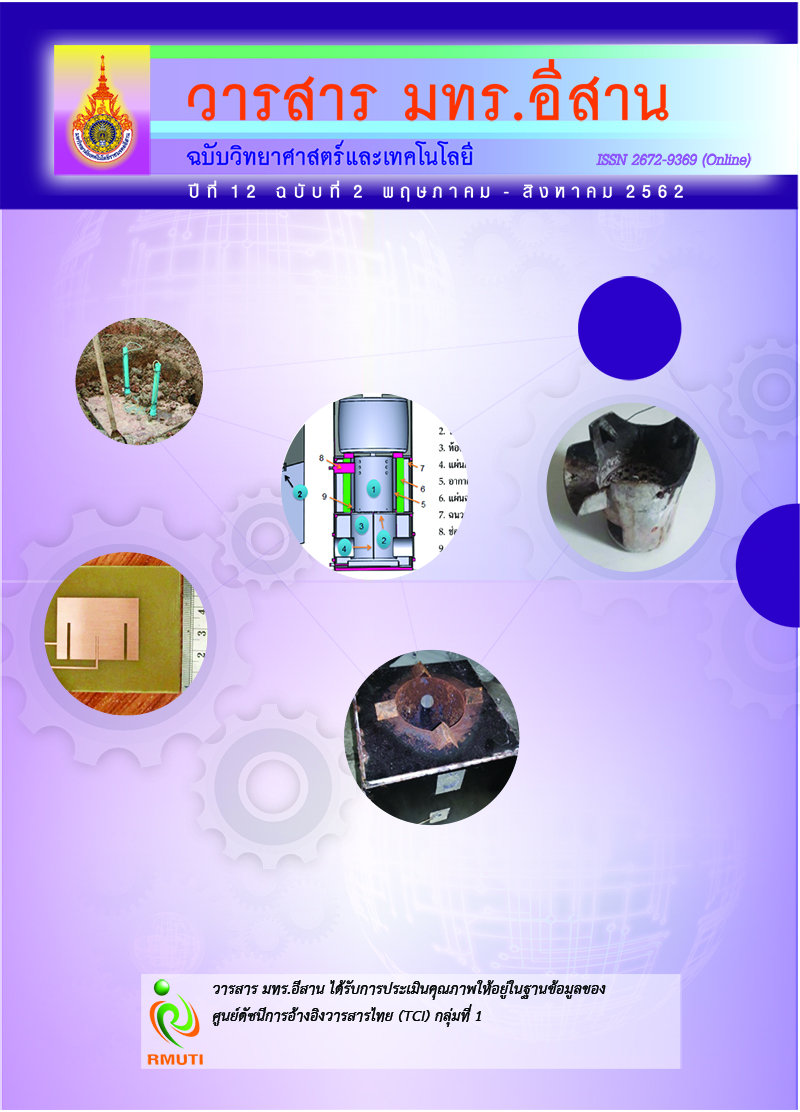ฤทธิ์ต้านอนุมูลอิสระของสารสกัดแคหางค่าง เขืองใหญ่ มะเดื่อดิน และผลด้านความเป็นพิษต่อเซลล์ชนิดไฟโบรบลาสต์ของผิวหนังมนุษย์
Main Article Content
บทคัดย่อ
งานวิจัยนี้มีวัตถุประสงค์เพื่อศึกษาฤทธิ์ต้านอนุมูลอิสระของสารสกัดจากพืชสมุนไพรไทย 3 ชนิด ได้แก่ แคหางค่าง (Markhamia stipulata) เขืองใหญ่ (Caryota maxima) และมะเดื่อดิน (Amphineurion marginatum) และศึกษาผลด้านความเป็นพิษของสารสกัดต่อเซลล์ชนิดไฟโบรบลาสต์ของผิวหนังมนุษย์ โดยสกัดสารด้วยตัวทำละลายเมทานอลหาปริมาณฟีนอลิกรวมด้วยวิธี Folin-Ciocalteu วิเคราะห์ความสามารถ ในการต้านออกซิเดชันโดยวิธี 2,2-diphenyl-1-picrylhydrazyl (DPPH) radical scavenging assay และวัดความสามารถของสารต้านอนุมูลอิสระในการให้อิเล็กตรอนอิสระด้วยวิธี Ferric Reducing Antioxidant Power (FRAP) Assay ผลการศึกษาพบว่า สารสกัดจากมะเดื่อดินมีปริมาณฟีนอลิกรวม มากที่สุด โดยมีค่าเท่ากับ 106.34±2.40 mgGAE/g extract และยังมีฤทธิ์ในการต้านอนุมูลอิสระสูงที่สุด เมื่อทดสอบด้วยวิธี DPPH โดยมีค่า IC50 เท่ากับ 11.15±0.01 mg/L และความสามารถในการให้อิเล็กตรอนอิสระของสารสกัดเมื่อทดสอบด้วยวิธี FRAP พบว่าสารสกัดทั้งหมดมีความสามารถในการให้อิเล็กตรอนอิสระ และมีฤทธิ์เพิ่มขึ้นตามความเข้มข้นที่ใช้โดยพบว่าสารสกัดจากมะเดื่อดิน มีความสามารถในการให้อิเล็กตรอนอิสระได้ดีที่สุด รองลงมาคือ สารสกัดจากเขืองใหญ่ และสารสกัดแคหางค่าง ตามลำดับ ผลการทดสอบความเป็นพิษต่อเซลล์ชนิดไฟโบรบลาสต์ของผิวหนังมนุษย์ของสารสกัดสมุนไพร พบว่าที่ระดับความเข้มข้น 62.5 ถึง 1,000 mg/L สารสกัดเขืองใหญ่ ไม่แสดงความเป็นพิษต่อเซลล์ไฟโบรบลาสต์ของผิวหนังมนุษย์ ส่วนสารสกัดแคหางค่าง และสารสกัดมะเดื่อดินแสดงความเป็นพิษต่อเซลล์ไฟโบรบลาสต์ของผิวหนังมนุษย์ที่ความเข้มข้น 1,000 mg/L จากงานวิจัยนี้แสดงให้เห็นว่าสารสกัดจากเขืองใหญ่และมะเดื่อดินที่สกัดด้วยตัวทำละลายเมทานอลมีสารที่มีฤทธิ์ต้านอนุมูลอิสระที่ดี แต่มีความเป็นพิษต่อเซลล์ไฟโบรบลาสต์ของผิวหนังมนุษย์ตํ่า
Article Details
เอกสารอ้างอิง
[2] Papus, M. A. (1998). Antioxidants Status, Diet, Nutrition and Health. U.S.A: CRC Press
[3] Kaewamatawong, R. and Jounmunkong, Z. (2006). DPPH Free Radical Scavenging Activity and Total Phenol Compounds Content of Some Thai Medicinal Plant Extracts. Journal of Ubon Ratchathani university. Vol. 8, No. 2, pp. 76-88 (in Thai)
[4] Halee, A. and Rattanapun, B. (2017). Study of Antioxidant Effcacies of 15 Local Herbs. KMUTT Research and Development Journal. Vol. 40, No. 2, pp. 283-293 (in Thai)
[5] Ipek, S., Esra, K. A., Lutfun, N., and Satyajit, D. S. (2012). Wound Healing and Antioxidant Properties: Do They Coexist in Plants?. Free Radicals and Antioxidants. Vol. 2, Issue 2, pp. 1-7
[6] Yaraksa, N. (2019). Antibacterial Activity Against four Human Pathogenic Bacteria and Anti-inflammatory Activity Evaluated from Five Thai Medicinal Plants. SNRU Journal of
Science and Technology. Vol. 11, No. 1, pp. 1-10
[7] Singleton, V. L. and Rossi, J. A. (1965). Colorimetry of Total Phenolics with Phosphomolybdic-Phosphotungstic Acid Reagents. American Journal of Enology and Viticulture. Vol. 16,
pp. 144-158
[8] Kriengsak, T., Unaroj, B., Kevin, C., Luis, C-. Z., and David, H. B. (2006). Comparison of ABTS, DPPH, FRAP, and ORAC Assays Forestimating Antioxidant Activity from Guava Fruit Extracts. Journal of Food Composition and Analysis. Vol. 19, pp. 669-675. DOI: 10.1016/j.jfca.2006.01.003
[9] Manok, S. and Limcharoen, P. (2015). Investigating Antioxidant Activity by DPPH, ABTS and FRAP Assay and Total Phenolic Compounds of Herbal Extracts in Ya-Hom Thepphachit.
Advanced Science. Vol. 15, No. 1, pp. 106-117
[10] Sharma, N. K., Dey, S., and Prasad, R. (2007). In Vitro Antioxidant Potential Evaluation of Euphorbia hirta L. Pharmacologyonline. Vol. 1, pp. 91-98
[11] Satsue, S., Thapphasaraphong, S., and Damrongrungruang, T. (2014). Antioxidant and Collagen Stimulating Activities in Human Gingival Fibroblast Cell Culture of Plant Extracts.
Isan Journal of Pharmaceutical Sciences. Vol. 9, (Supplement), pp. 38-43 (in Thai)


